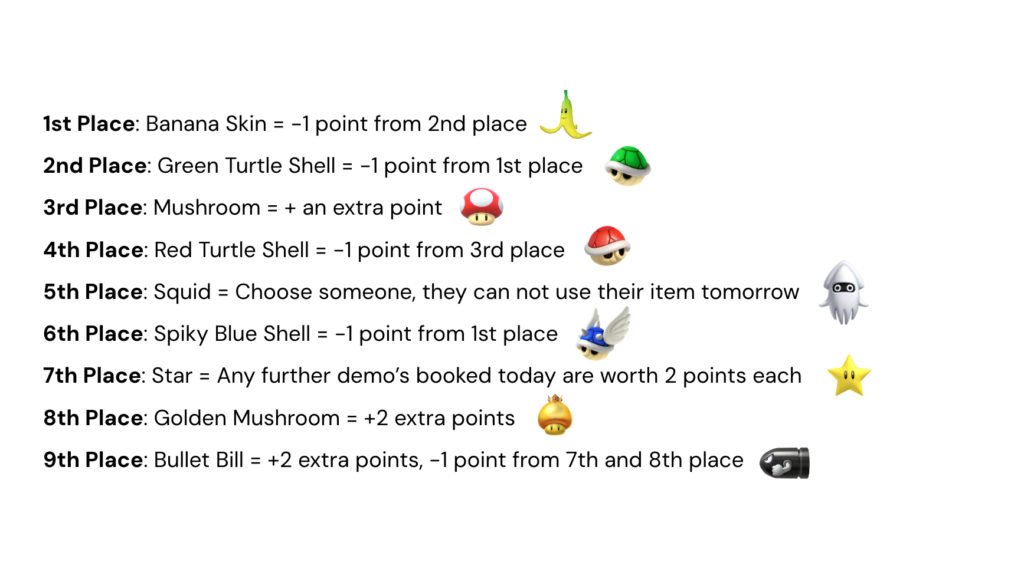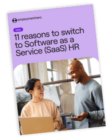Gamification in HR: A powerful tool for employee experience
Loyalty points (or Hero Points for us), accrued holiday and learning certifications. All examples of ways you can gamify HR leading to increased engagement.

If you’re anything like us at Employment Hero, you’re always on the lookout for new ways to influence employee engagement, productivity and job satisfaction. One way you could do that: gamification.
Integrating game-like elements into various aspects of human resources may help you foster a more motivated and productive team. To make the most of this exciting approach, let’s explore how you could use gamification in HR to your advantage and keep your team on their toes.
What is gamification in HR?
Gamification in HR is the application of game-like elements, such as competition, rewards, and challenges, to various aspects of the HR function to motivate and engage employees, enhance their performance, and achieve organisational goals. It involves using game mechanics and principles to create a more engaging and interactive work environment. While it may not streamline your processes, it can add a layer of fun to them for your team.
It can be applied to software, training and learning materials or everyday tasks.
How can gamification benefit employee experience?
The aim of gamification in a workplace context is to increase employee engagement, motivation, and productivity, as well as to create a more enjoyable and fulfilling work environment. Gamified software (particularly in learning and development) can also have a positive impact on employee morale; the same research shows that 88% of employees say that the gamification in the software they use at work makes them happier.
However, in some cases gamifying a process could inadvertently create competition or stress that could be detrimental to workplace culture. So, it’s important to keep your finger on the pulse here.
Some different examples of gamification in HR
Incentivising everyday tasks: Team Mario Kart
To put this idea into perspective, recently our sales development team (SDRs) coined a challenge that saw them compete to bring in demos for our platform. While it’s not an HR-specific example, the idea could easily be applicable to any function.
(Apologies if you’re not familiar with Mario Kart, but hopefully you can still see how the concept of a race incentivises team performance through gamification.)
The rules were simple
- Everyone starts on zero points.
- At the start of every day the table is updated to show what position you’re in, how many points you’re on and what item you have access to.
- Assign points to certain HR tasks that your team can log and keep score on.
- To unlock and use your item on any given day you have to first complete a task. You may only use an item once per day.
- Your position in the table is only updated at the end of the working day, your item will not change throughout the day.
- If you are using your item, you must specify following your demo booking in the correct Slack channel.
- You cannot carry items over from day to day.
How to use your items

What were the results?
Each day the Slack channel was abuzz with changes in position, competitive speak and the use of items to the delight of some, and the competitive dismay of others. It brought the team together and showed how a simple incentive could really change the feel of a work week.
Deloitte and onboarding
Deloitte has taken steps to change how they onboard their team. New hires get to team up with other newcomers and dive into topics like privacy, compliance, ethics and procedures, but with a twist – it’s all online and feels like a game. They can toss out questions for their team, and everyone chimes in with their answers. Then they chat it out until they come up with a single, solid answer. It’s a mix of learning and teamwork that makes new starters feel like they belong from day one.
That’s not all. Deloitte has a virtual office tour. You start at the airport, and you get to pick your destination – Beijing, Shanghai or Hong Kong. From there, you “fly” to your chosen city and land in the virtual Deloitte office. Their new starters can chat with employees and get a feel for the company’s culture.
Finding new team leaders with an adventure game
Across their global team, NTT (a digital transformation company) uses a game called ‘Samurai’ (developed solely for their staff’s use purposes) to test leadership qualities. Their employees answer a series of questions before joining a quest and making decisions to show how good they are at managing others. The game helps NTT find leaders within the company and gives insights on who needs more help to advance their careers.
Key elements of gamification
Gamification can be applied to various contexts, including HR, marketing, sales, education and more.
Here are the elements to be aware of:
Goals & objectives
Clearly defined goals and objectives give participants a sense of purpose and direction, motivating them to engage with the gamified experience.
Feedback
Regular and constructive feedback informs participants about their progress and performance, keeping them engaged and focused on improvement.
Rewards & incentives
Well-designed rewards and incentives serve as powerful motivators, encouraging participants to complete tasks, achieve goals, and excel in the gamified system.
Competition & collaboration
Incorporating elements of competition and collaboration adds excitement and social interaction, fostering engagement and a sense of community.
Progression
Providing a sense of progression, such as advancing through levels or ranks, instils a feeling of accomplishment and encourages participants to continue their engagement.
If you’re hoping to implement gamification, don’t forget to balance and tailor these elements to match your objectives. For instance, there’s no use in implementing a timer if you’re not looking to measure speed. The effectiveness of your game will rely heavily on how well you can engage and motivate your participants.
How can companies adopt HR gamification mechanisms?
Employee onboarding
Gamification can be employed to make the onboarding process more interactive and engaging. New employees can complete training modules, quizzes and challenges in a game-like format, making it more enjoyable and effective. Like that Deloitte example above, you could turn your onboarding into a non-competitive gaming environment where your new starter competes against themselves to showcase understanding.
Maybe get started with Business Smart as a provider.
Training & development
Training programmes can be gamified to encourage employees to acquire new skills or knowledge. This can involve earning badges, points or rewards for completing training modules or showing proficiency in certain areas.
Performance management
Gamification can be applied to performance reviews and goal-setting. Employees can set and track their goals on a gamified platform, earning rewards or recognition when they achieve specific milestones. If you’re using Employment Hero you could build these incentives into your 1:1s where you have full control over the questions you ask and how your team feeds back to you.
Employee engagement
Gamified systems can be used to foster employee engagement. For example, companies might implement a points system or competition to encourage employees to participate in wellness programmes, attend company events or provide suggestions for process improvements.
Why not take a look at a provider like Peek & Poke for branded games.
Rewards & recognition
Gamification can be used to create a more dynamic and motivating rewards and recognition system. Employees can earn points or badges for exceptional performance, and these can be redeemed for various rewards or incentives.
Employee feedback
Gamified platforms can encourage employees to provide feedback, suggestions or ideas for improvement in a fun and interactive way. This can enhance the feedback culture within an organisation.
Team building
Games and challenges can be incorporated into team-building exercises to improve collaboration and camaraderie among employees.
Is gamification suitable for all types of businesses?
Just as the above examples show, when done right, gamification could be applicable to many processes, but it might not be suitable for every situation. Here are some things to think about:
Organisational culture
Your organisation’s culture and values should align with the gamification approach, if you’re fast-moving, always looking for new ways to try things (that might not work), then it could be suitable. But if you’re in a more risk-averse culture, or an industry that can’t leave results to chance, gamification might not fit. Some cultures may not embrace competition or gamified elements, so it’s essential to consider cultural fit.
Process complexity
Gamification is more suitable for processes that can be broken down into clear, achievable goals or milestones. Like the example, if it’s something simple, there’s an easy fit. For highly complex or abstract processes it may not benefit as much.
Overuse
Overusing gamification or applying it to every HR process can lead to employee fatigue or make it less impactful. Try to strike a balance and reserve gamification for processes where it adds value, or if you need to inject energy into a common task.
Employee preferences
Consider the preferences of your employees. Not everyone may respond positively to gamification, or want to take part. Before you start, gauge your team’s reactions and adapt accordingly.
ROI & effectiveness
Evaluate whether gamification improves the intended outcomes for each HR process. If it doesn’t provide a tangible return on investment or doesn’t align with the desired results, it may not be the best approach.
While gamification can be a valuable tool for HR leaders to spur their team on, its suitability depends on the specific process and your organisation’s culture. Carefully consider how and where gamification is applied to ensure it enhances, rather than detracts from your processes.
How can companies measure the success of gamification initiatives?
How you measure gamification will all depend on the desired outcome. If your intention was to add some competition to BAU tasks, then you’re going to have a much easier task than if you’re looking to change a business process on an ongoing basis to increase productivity, engagement or something similar.
Regardless of the level of gamification you’re going for, here are some examples of how you could approach measurement:
Key Performance Indicators (KPIs) or Objectives & Key Results (OKRs)
Define specific KPIs that directly relate to the goals of the gamification initiative. These KPIs provide a clear and quantifiable measure of success. In Employment Hero, you can assign each employee their own OKRs that link back to business objectives. These are public-facing, so could also be gamified.
Leaders and Managers could incentivise staff to keep track of their OKRs or complete them within a certain timeframe. Again, it doesn’t have to be competitive.
Engagement metrics
Monitor engagement levels, including participation rates and time spent within the gamified system, as increased engagement is a strong indicator of success.
Performance improvements
Assess whether the gamification initiative has led to tangible performance improvements, such as increased productivity or reduced turnover.
Feedback & surveys
Collect feedback from participants to gauge their perceptions, motivation, and suggestions for improvement. User feedback provides valuable insights into the success of the programme.
Engage employees with Employment Hero
Overall, gamification gives you the tools to inject some competition into your HR processes, which could boost employee engagement. By infusing elements of competition, rewards, and interactive challenges into onboarding, training, performance management, and other HR functions, you can motivate your workforce and foster a culture of continuous improvement.
When looking to bring these gamification ideas into your business, an AI-powered HR platform becomes a valuable ally. Employment Hero’s HR software offers you an easy way to give employees shoutouts, recognition, share company news and incentivise staff through benefits in the EH Work app. Employment Hero offers a whole host of benefits for you and your team. If you’re interested in how the platform could work for you, reach out and talk to a member of our team.
Related Resources
-
 Read more: Employment Rights Bill Timeline: Key Dates for Employers
Read more: Employment Rights Bill Timeline: Key Dates for EmployersEmployment Rights Bill Timeline: Key Dates for Employers
The UK Employment Rights Bill is coming. Discover the key dates from 2026 to 2027, and learn how to prepare…
-
 Read more: 7 common types of leadership styles and how to find yours
Read more: 7 common types of leadership styles and how to find yours7 common types of leadership styles and how to find yours
Learn the 7 most common types of leadership styles, their strengths and how to identify your own – with guidance…
-
 Read more: Unauthorised Absence From Work: A Complete Guide
Read more: Unauthorised Absence From Work: A Complete GuideUnauthorised Absence From Work: A Complete Guide
Absences that aren’t authorised can disrupt productivity & morale. Learn to manage them effectively, comply with employment law & prevent…












